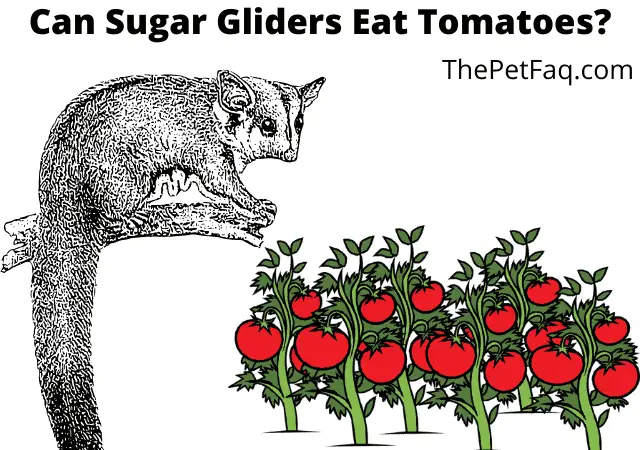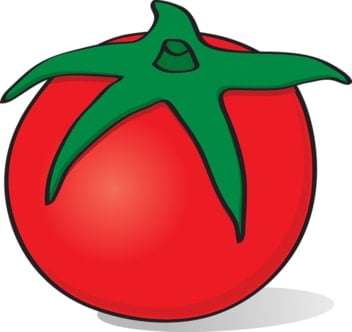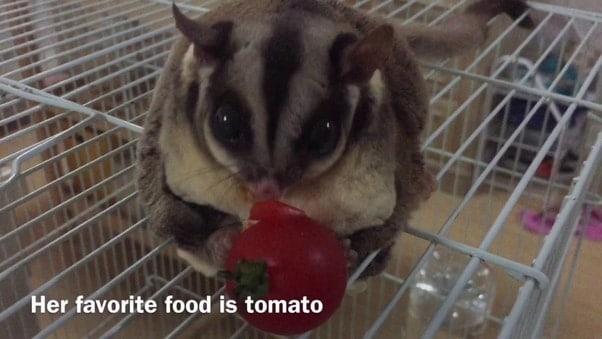Have you ever wondered: “Can sugar gliders eat tomatoes?”, I have and I’m sure many other sugar glider owners have as well. Sugar gliders are notoriously difficult to feed. Whereas other pets can be fed quite simply with a diet of pellets sugar gliders are quite a lot tougher to satisfy. It’s therefore not all that surprising that many people have questions about what they can (and can’t) eat safely.
I did a lot of research on the subject and would like to share my findings with you today. In this post, I’ll go over everything you need to know before feeding tomatoes to your glider. I’ll cover whether or not this is a safe food for your glider to consume, whether they enjoy eating it, and much more.
Luckily, tomatoes are safe to eat for sugar gliders in small quantities. As long as the tomato is fresh and well-washed, it does not pose a threat to your furry friend. Do make sure that you never feed them the leaves or the stem, as those are harmful.

What’s (in) a tomato anyway?

There’s a lot of confusion regarding tomatoes. Many people are not sure if they’re fruits or vegetables. I have to admit that when I started doing my research for this article I wasn’t 100% sure either.
Turns out, the tomato is botanically a fruit. In fact, it’s a berry from the Solanum Lycopersicum more commonly known as the tomato plant. However, even though they are botanically considered to be fruits, culinary they’re considered vegetables. This makes it quite understandable where all the confusion comes from! From now on I will refer to them as vegetables since that’s what most people believe them to be, just so we’re clear.
Now, let’s take a look at what’s in this vegetable, shall we? That way we can determine if it’s safe for consumption for sugar gliders.
100 grams of tomatoes contains the following:
- 18 calories
- 95% water
- 0.9 grams of protein
- 3.9 grams of carbs
- 2.6 grams of sugar
- 1.2 grams of fiber
- 0.2 grams of fat
Now, let’s take a look at the nutrition above. As we can see the vegetable is very low in calories, which makes sense since it’s made up of 95% water which of course contains 0 calories. The rest is made up mainly of sugar, fiber, and protein with a very tiny amount of fat. All in all, there’s nothing bad to see here. The fact that it has a low amount of fat and calories is excellent and the fact that it has quite a bit of fiber makes it even better.
However, that’s not all that’s in these vegetables. We can’t forget about the micronutrients (vitamins and minerals). Let’s take a look at which vitamins and minerals they contain in good quantities.
Antioxidants
Tomatoes are quite rich in vitamin C. Vitamin C is an antioxidant that protects your glider from age-related diseases and DNA damage. In addition, vitamin C is good for their immune system.
Other antioxidants that are found in this food are Lycopene, beta carotene, and Chlorogenic acid.
Vitamin K1
This vegetable also contains a decent amount of vitamin K1. Vitamin K1 is essential for strong bones!
Vitamin B9
Vitamin B9, also known as Folate is a vitamin that aids metabolism, in other words; it helps your sugar glider extract energy from the food you give them.
Potassium
Another mineral this vegetable is rich in is potassium. This mineral helps your glider have a strong heart.
Calcium phosphorus ratio
For sugar gliders, it’s important to think about the calcium to phosphorus ratio when you feed them. This is important because if they do not have the correct ratio in their diet it can lead to problems such as hind leg paralysis.
Ideally, you want your glider to have a diet that has between 1 to 2 times more calcium than phosphorus. In other words, the diet of your glider should not have less calcium than phosphorus.
Green tomatoes have different calcium to phosphorus ratios than their red counterparts. Let’s take a look at the ratio of both.
1 Cup Green: 23.4 mg calcium – 50.4 mg phosphorus – ratio: 0.5:1
1 Cup Red: 9 mg calcium – 43.2 mg phosphorus – ratio: 0.2:1
As you can see, green tomatoes have better calcium to phosphorus ratios for sugar gliders. Also, you might think that tomatoes are not good food for gliders because they do not adhere to the calcium/phosphorus ratio. However, just because a certain food does not fall within the ratio does not mean they cannot eat it. They can, as long as their total diet is in adherence to the ratio.
Also, the calcium to phosphorus ratio can sometimes be a bit misleading:
Unfortunately, Ca:P ratios can be misleading as it is a comparative and not an absolute value. For example, if a food item has 1800 mg of calcium and 1000 mg of phosphorus, it would have a ratio of 1.8:1. Consider a food item with 5mg of Calcium and 1mg of Phosphorus. This would have a ratio of 5:1. In terms of nutrition, the food item with a Ca:P ratio of 1.8:1 contains far more Calcium than the second food item, and is more nutritious, even with a substandard Ca:P ratio.
Can sugar gliders eat tomatoes?

Now that we’ve taken a look at what’s in this vegetable it’s time to answer the question of whether or not they can eat it. The answer to this question is: Yes, sugar gliders can eat tomatoes. Tomatoes are a low-calorie, low-fat vegetable (or fruit, depending on who you ask) that contains many essential vitamins, minerals, and antioxidants. On top of that, they’re a good source of fiber which aids digestion. All-in-all, they’re a good food to include in your glider’s diet as long as you feed it to them fresh and not canned.
Make sure to properly wash it to remove any pesticides and cut it into pieces before feeding it to your glider and you’re good to go! You can also consider giving them cherry tomatoes instead, these are very small and quite an ideal size for your tiny glider to hold in their tiny paws.
However, it should be noted that sugar gliders require a balanced diet consisting of many diverse kinds of fruits, vegetables, and proteins.
While tomatoes are good for them they should not be the only thing they eat or a large part of their diet. They benefit the most if you give them small amounts of it in addition to other fruits and vegetables.
What about the seeds, leaves, and stems?
The leaves and stems must be avoided. Tomatoes are part of the nightshade family and their leaves and stem are toxic. Never give those to your glider.
As far as the seeds go, they do not pose any threat to your furry friend. The seeds are very small so they do not pose a choking hazard and do not contain anything harmful.
There are reports that sugar gliders will avoid the seeds and instead start throwing them at each other, so beware of that…
Can they eat tomato sauce or juice?
If you buy tomato sauce or passata from the supermarket you should not feed it to your glider. It’s very frequently loaded with way too much sugar for your glider to eat. The same applies to juice that’s bought from the supermarket
It should be fine to juice the tomato yourself in a blender. After all, it’s still the same food just blended up into a juice.
Do sugar gliders like to eat tomatoes?

This is a question that pops up frequently when you talk about any food. It makes sense why. People of course want to know if their pets will like a certain food before they feed it to them. Unfortunately, there’s never a definitive answer to this question since it highly depends on your glider.
They’re all individuals with individual likes and dislikes. Perhaps your glider will like to eat a tomato, perhaps he will not. If he does not, do not worry. There are many other fruits and vegetables you can feed him such as:
Figuring out what your glider likes and doesn’t like is one of the most fun things about owning a glider. You’ll just have to experiment! For some ideas on what to feed your glider, check out my sugar glider nutrition guide.
Final words
I think that’s all you need to know about tomatoes and sugar gliders. Now you know that you can safely feed them to your glider!
To give your sugar glider optimal nutrition it needs a balanced diet of many different kinds of foods and tomatoes can definitely be a part of that.
- How Long Do American Eskimo Dogs Live? Important Factors and Care Tips - September 29, 2023
- Do American Bulldogs Need Grooming? Essential Tips and Care Guidelines - September 29, 2023
- Do Bengal Cats Enjoy Playing? Essential Tips for Keeping Them Active - September 29, 2023